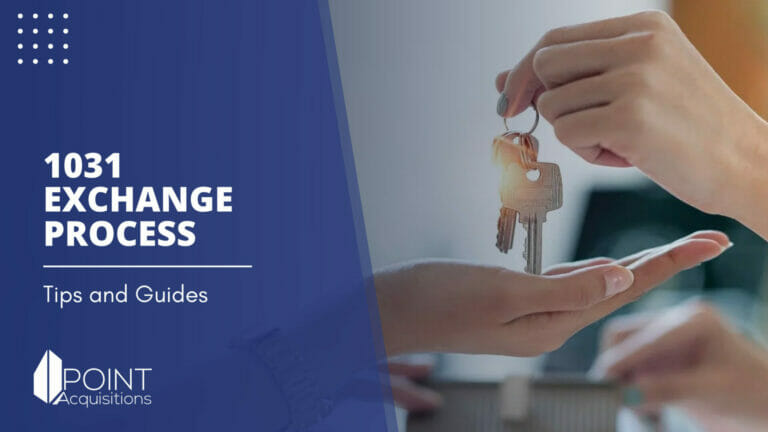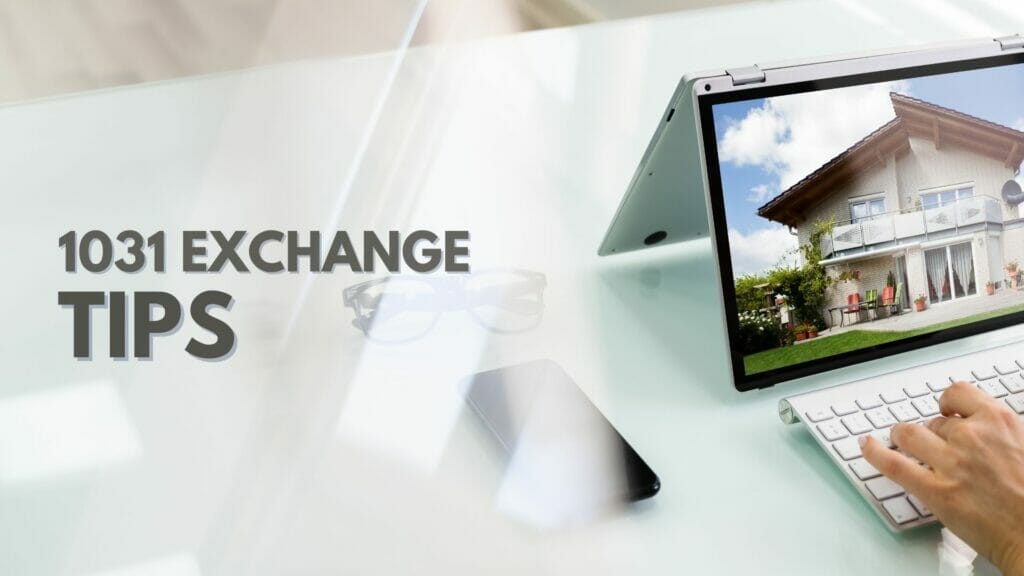
12-Step Guide to the 1031 Exchange Process and Tips to Follow
Navigating the real estate market successfully requires a keen understanding of how to leverage tax strategies to one’s advantage. Among the most powerful tools at a real estate investor’s disposal is the 1031 exchange process.
This tax-deferral mechanism, sanctioned under the Internal Revenue Code, presents a pathway for investors to postpone capital gains taxes that would otherwise be due upon the sale of an investment property. By reinvesting the proceeds into another property of similar or like-kind, investors can not only defer taxes but also reinvest in growth opportunities, optimize their investment portfolio, and enhance their financial leverage.
This guide aims to walk you through the 1031 exchange process, offering clear, actionable insights that pave the way for making informed investment decisions. From understanding the principles that define like-kind exchanges to navigating the timing and procedural nuances, our goal is to give you strategic knowledge and practical tips.
Whether you’re looking to expand your investment horizon or seeking to optimize your tax position, the insights shared here will serve as your roadmap to harnessing the full potential of the 1031 exchange.

Table of Contents
Step-by-Step Guide to Execute The 1031 Exchange Process
A 1031 exchange presents a strategic opportunity for real estate investors to defer capital gains taxes while repositioning their investment assets.
The below steps designed to simplify the 1031 exchange process with precision, offering you a structured pathway through its complexities:
1. Determine if a 1031 exchange is right for you
Deciding if a 1031 exchange is right for you requires evaluating key factors. Consider the potential tax savings, alignment with investment objectives, property portfolio analysis, replacement property options, financial considerations, and time commitment.
Consulting with a qualified intermediary and tax professional specializing in 1031 exchanges ensures personalized guidance tailored to your circumstances. This ensures an informed decision that aligns with your financial goals.
To help with your decision, read our post on 1031 exchanges.
2. Inform your financial advisor or estate planning attorney about your 1031 exchange
Informing your financial advisor or estate planning attorney about your intent to pursue a 1031 exchange is vital for comprehensive guidance and optimal outcomes. Their expertise in tax and financial considerations, integration with your investment strategy, and professional guidance ensure a compliant and efficient exchange.
Additionally, they can assess estate planning implications and provide holistic advice that considers all relevant aspects of your financial situation. Collaborating with these professionals maximizes the benefits of your 1031 and safeguards your long-term financial well-being.
3. Develop a transition strategy with your 1031 exchange advisor
Collaborating with a 1031 exchange advisor to develop a transition strategy is essential for a successful exchange process. Their expertise in facilitating like-kind exchanges ensures you receive expert guidance throughout the transition. They will assist you in property identification, due diligence, financial planning, and coordinating with other professionals. By leveraging their knowledge and experience, you can navigate potential challenges, make informed decisions, and optimize the outcome of your exchange. A well-developed transition strategy provides a structured approach, minimizes risks, and ensures a smooth transition from your relinquished property to the replacement property.

4. Identify the property you want to sell
The next step in the exchange process is identifying the property you want to sell, known as the relinquished property. Evaluate your investment portfolio, considering cash flow, market conditions, and growth potential. Consulting professionals such as real estate agents or appraisers can provide insights into the property’s market value.
Remember the strict timelines of the exchange, with a 45-day window to identify a replacement property. Taking the time to select the property you intend to sell carefully sets the foundation for a successful 1031.
5. Identify the property you want to buy
The next step in the 1031 exchange process is identifying the property you want to buy as a replacement. Consider your investment objectives, such as location, property type, and growth potential. Conduct market research to analyze trends and opportunities.
Seek guidance from real estate professionals specializing in your desired property type. Explore financing options and be mindful of the strict timelines the IRS sets. By carefully selecting the replacement property, you can ensure it aligns with your investment goals and complete the exchange.
6. Select a qualified intermediary and open an exchange
Selecting a qualified intermediary (QI) and opening an exchange account is crucial in the exchange process. Conduct thorough research to find a reputable QI with expertise in 1031 exchanges. Consult with qualified intermediary to understand the process and complete the necessary paperwork. Partnering with a QI can help you navigate the complexities of the exchange process.
Open an exchange account with the QI, depositing the proceeds from the sale of the relinquished property. They will coordinate the exchange, hold funds in an escrow account, and ensure compliance with IRS regulations to help facilitate a successful transaction.

7. Enter into a contract to sell your existing investment property
To initiate the 1031 exchange process, you must enter into a contract to sell your existing investment property. Determine the property’s fair market value through a professional appraisal and establish a competitive listing price. Market the property, conduct showings, and negotiate offers with potential buyers.
Once you reach an agreement, sign a purchase agreement. Open an account with an escrow company or attorney to facilitate closing. This step sets the groundwork for the subsequent stages of the 1031 exchange.
8. Enter into a contract to buy your replacement investment property
Entering into a contract to purchase your replacement investment property is essential. Collaborate with your real estate broker to submit a written offer, including key details such as price, contingencies, and desired closing date. Negotiate with the seller if necessary to reach mutually agreeable terms. Conduct thorough due diligence on the replacement property, including inspections and document reviews. Secure financing and fulfill any contingencies outlined in the purchase agreement.
Prepare for closing by completing the necessary paperwork and coordinating with the escrow company or attorney. By progressing through this step, you are on track to successfully acquire your desired replacement property within the framework of your 1031 exchange.
9. Decide how much of the sale proceeds will go toward the new property
When engaging in a 1031 exchange, deciding how much of the sale proceeds from your relinquished property will be used towards purchasing the new property is essential. Factors to consider include the value of the replacement property, debt and equity considerations, tax and financial objectives, and cash flow considerations.
Seek guidance from financial advisors, tax experts, and real estate professionals to make an informed decision that aligns with your investment goals and overall financial strategy. By carefully evaluating these factors, you can determine the optimal allocation of sale proceeds toward acquiring the new property within the framework of your 1031 exchange.
As a general rule, you will need to reinvest at least 95% of the value of the property you sold to qualify for the tax deferral benefits of a 1031 exchange. For more information on this, see our post on the 95% rule in a 1031 exchange.

10. Close on your 1031 exchange replacement property
The closing stage is the final step in the 1031 exchange process. Coordinate with the escrow company or attorney handling the transaction to complete the exchange. Review and sign all closing documents, ensuring they align with the agreed-upon purchase terms.
Coordinate the funds transfer from the qualified intermediary to the closing agent, who will then transfer the title to the replacement property. Retain copies of all closing documents for your records. By successfully closing on your replacement property, you finalize the exchange process, solidifying your ownership of the new property and realizing tax deferral benefits.
11. Handle the proceeds properly
Properly handling the proceeds from your 1031 exchange is crucial for compliance and maximizing the benefits of the exchange. Work closely with your qualified intermediary to follow their instructions regarding transferring and managing the funds. Avoid receiving the exchange proceeds directly and ensure they are held by the qualified intermediary in a separate exchange account. Use the qualified funds to purchase the replacement property within the designated timelines. Consult with tax professionals to understand tax implications and ensure compliance with tax laws. By adhering to these guidelines, you can appropriately handle the proceeds from your 1031 exchange, safeguarding the transaction’s tax-deferred status.
12. Tell the IRS about your transaction
Properly informing the IRS about your 1031 exchange transaction is essential for compliance with tax regulations. Include the details of your exchange on your tax return and attach Form 8824, specifically designed for reporting like-kind exchanges. You can get a more detailed explanation of the 1031 exchange IRS form here.
Consulting with a tax professional specializing in 1031 exchanges can provide valuable guidance and ensure accurate reporting. Keep thorough documentation of the transaction to support your reporting and demonstrate compliance.

1031 Exchange Process Tips
When engaging in a 1031 exchange, it’s important to keep these tips in mind to ensure a successful and compliant process:
Keep an eye on the calendar
The 1031 exchange process has strict timelines that must be followed. Stay vigilant and ensure you meet important deadlines, such as the identification period (45 days) and the exchange period (180 days) from the sale of the relinquished property.
Follow the 1031 exchange timeline
Adhering to a specific timeline is extremely important. Identify potential replacement properties within the designated period and complete the acquisition within the exchange period. Failure to meet these deadlines for your 1031 exchange may result in disqualification from the exchange.
After the exchange is complete, notify your tax advisor
It’s important to inform your tax advisor about the completion of your 1031 exchange. They can guide reporting requirements and ensure compliance with tax regulations.
Know the property requirements
Familiarize yourself with the property requirements and qualifications for a like-kind exchange. The replacement property must be like-kind to the relinquished property, typically within real estate. Seek professional advice to determine if your desired replacement property meets the necessary criteria.
Follow the exchange rules
Adhere to the exchange rules and guidelines set by the IRS. Avoid receiving the exchange funds directly, use a qualified intermediary to facilitate the transaction, and ensure the proper handling of proceeds. Compliance with these 1031 rules is important for a valid exchange.
By keeping an eye on the calendar, following the designated timeline, notifying your tax advisor, understanding property requirements, and adhering to the exchange rules, you can successfully navigate the 1031 exchange process and maximize tax deferral benefits.
How do I know if a 1031 Exchange is Right for Me?
Determining if a 1031 exchange is the right strategy requires careful evaluation of your financial goals, investment objectives, and tax considerations. Consider factors such as the potential tax savings, alignment with your investment strategy, and the availability of suitable replacement properties. It is crucial to consult with professionals specializing in 1031 exchanges, such as qualified intermediaries and tax advisors, who can provide personalized guidance based on your specific circumstances.
If you have questions about your property’s eligibility for a 1031 exchange, need assistance with your real estate investment strategies, or want have questions about getting a 1031 exchange investment contact us at Point Acquisitions.
Our team can guide you in the right direction and connect you with experts who specialize in 1031 exchanges and can provide the guidance and support you need to make informed decisions. Take advantage of the potential benefits of a 1031 exchange and reach out to Point Acquisitions today.
About The Author

Jesse Shemesh
Disclaimer
Please note that Point Acquisitions is not a tax expert or tax advisor. The information on our blogs and pages is for general informational purposes only and should not be relied upon as legal, tax, or accounting advice. Any information provided does not constitute professional advice or create an attorney-client or any other professional relationship. We recommend that you consult with your tax advisor or seek professional advice before making any decisions based on the information provided on our blogs and pages. Point Acquisitions is not responsible for any actions taken based on the information provided on our blogs and pages.
1031 Exchange Capital Gains Tax Deferral
According to a 2021 report by the National Real Estate Exchange Services (RES), over 240,000 1031 exchange transactions were completed in the United States, totaling $100 billion. This impressive figure underscores the role of 1031 exchanges in the real estate…
Read More1031 Exchange Benefits
As of Q4 2023, the national vacancy rate for all commercial property types in the United States sat at 9.2%, according to CBRE’s latest insights and research. This represents a slight decrease compared to the previous quarter and suggests a…
Read More1031 Exchange Legal Considerations: A Must-Read Guide
You’re in the right place if you’re considering a 1031 exchange for your commercial real estate investments. Whether you’re a seasoned investor or just dipping your toes into the market, understanding the legal landscape of 1031 exchanges is key to…
Read More

